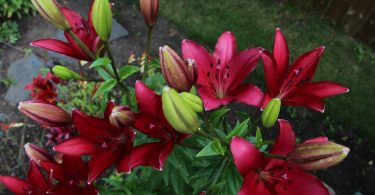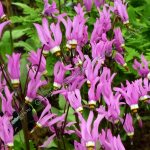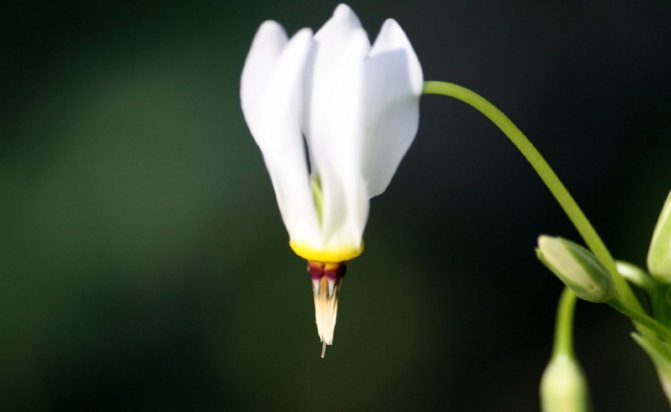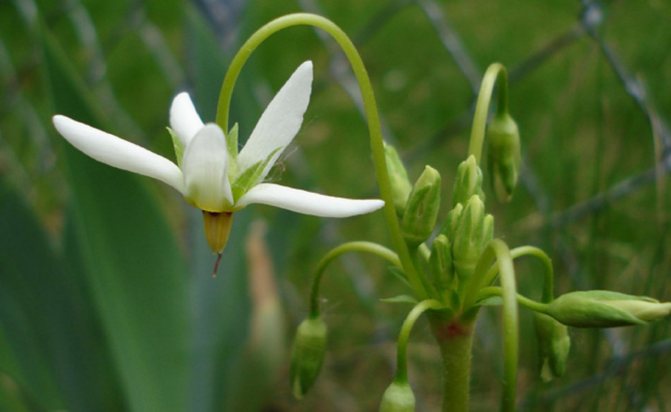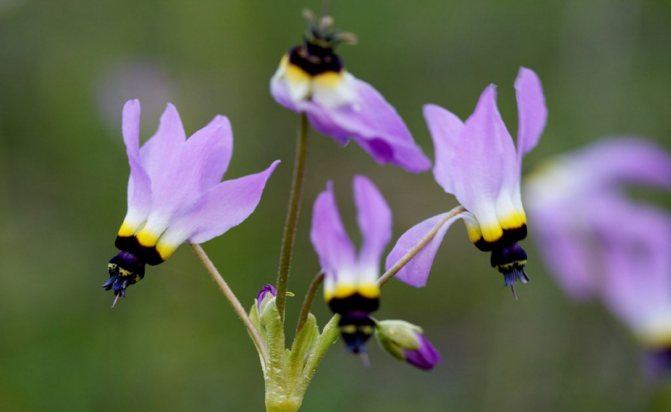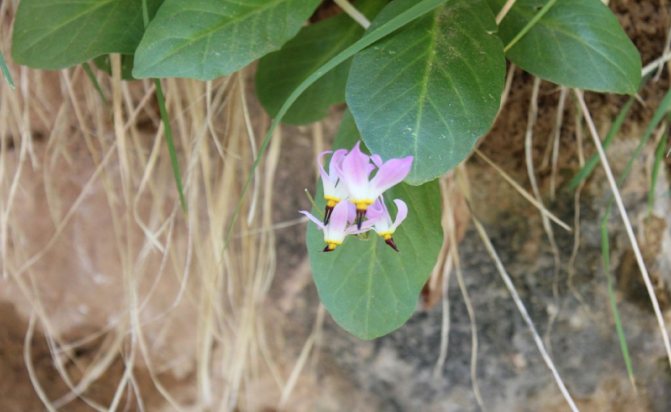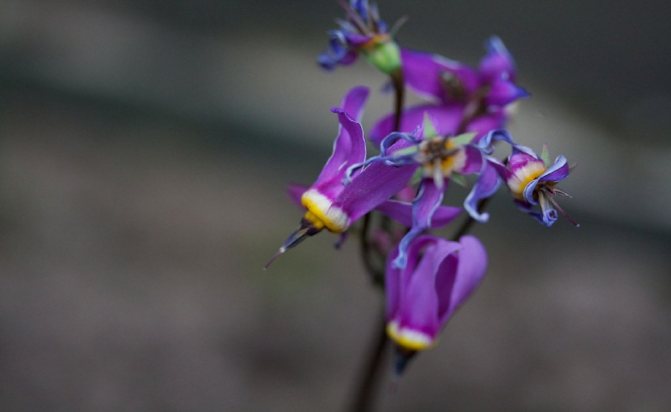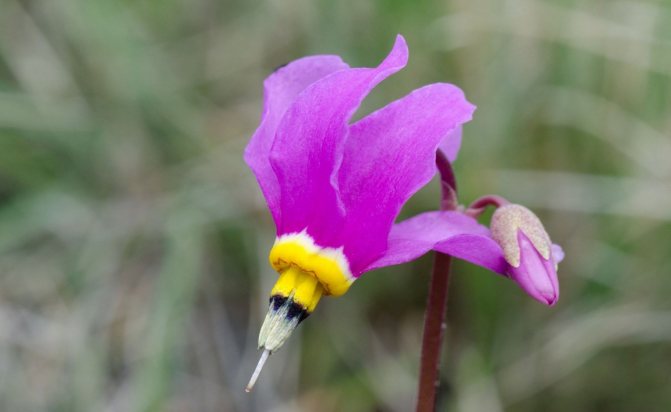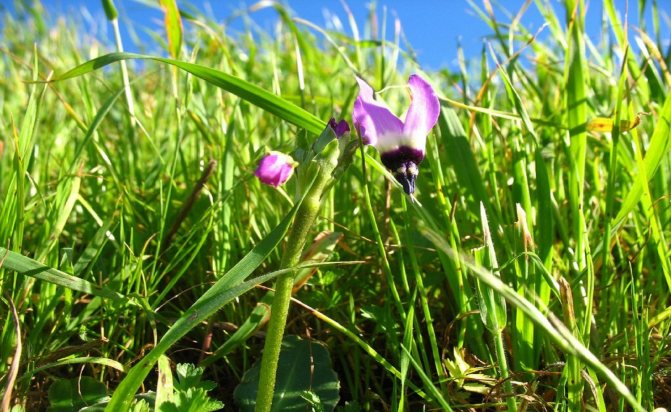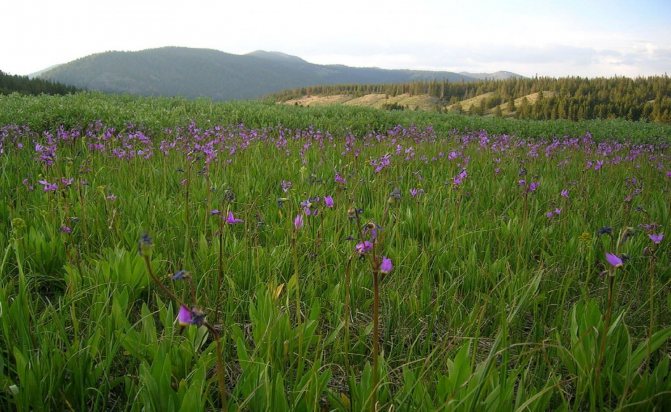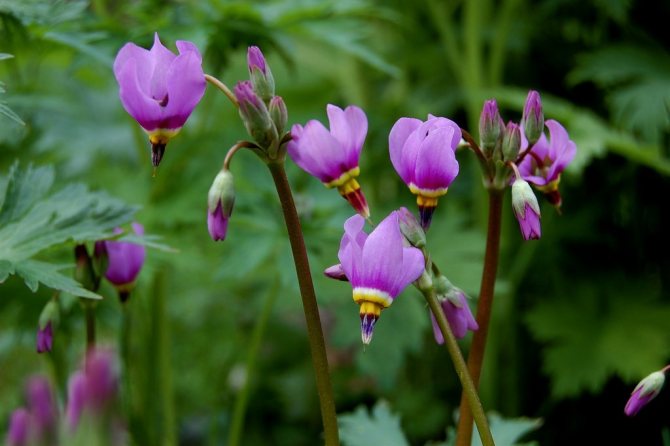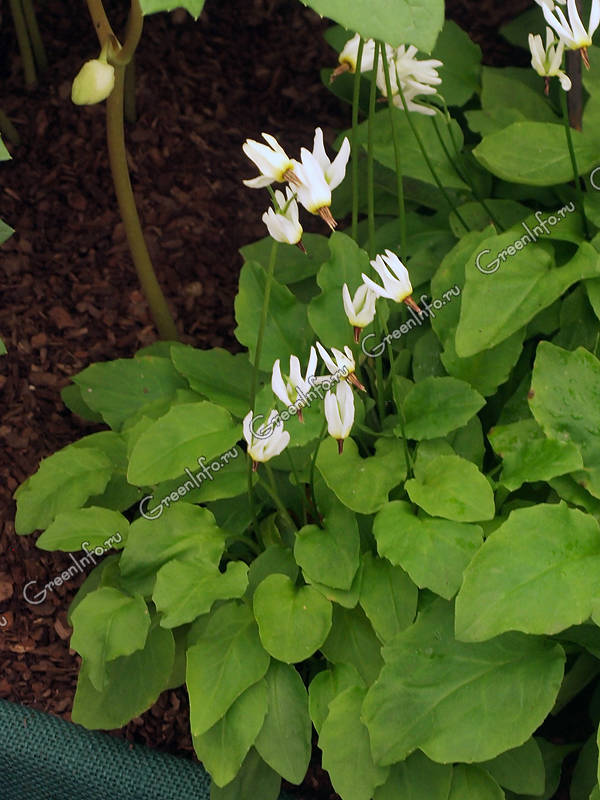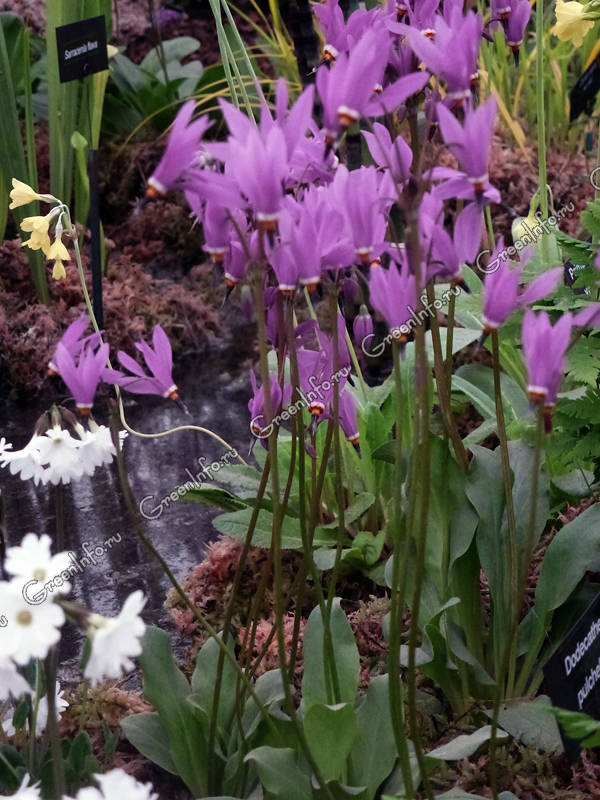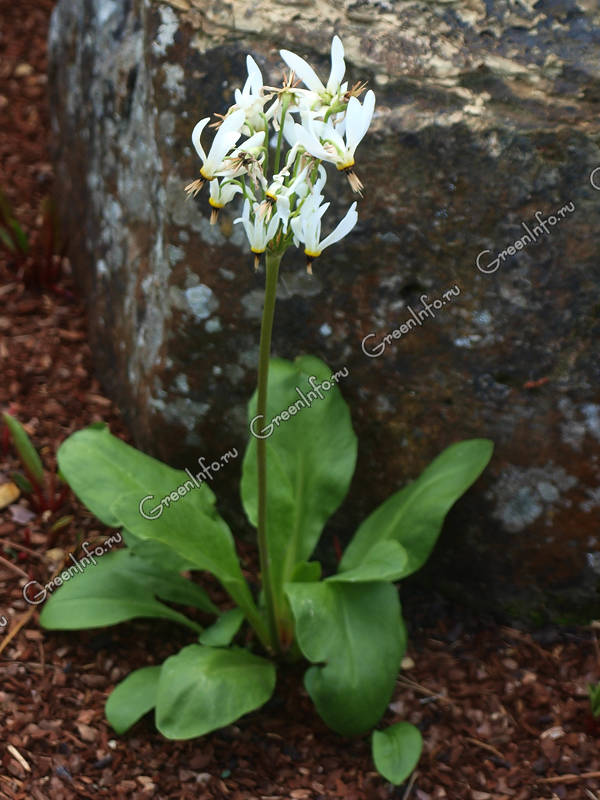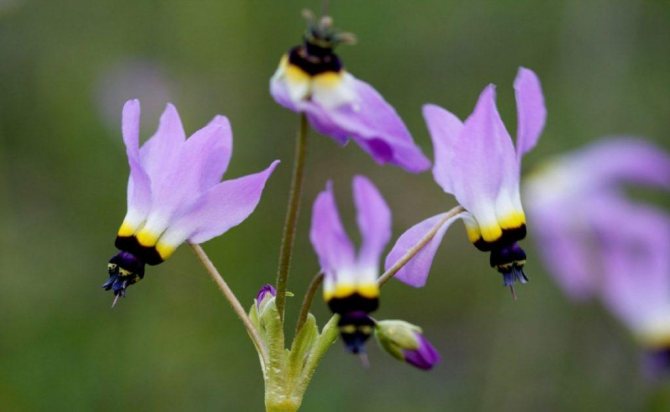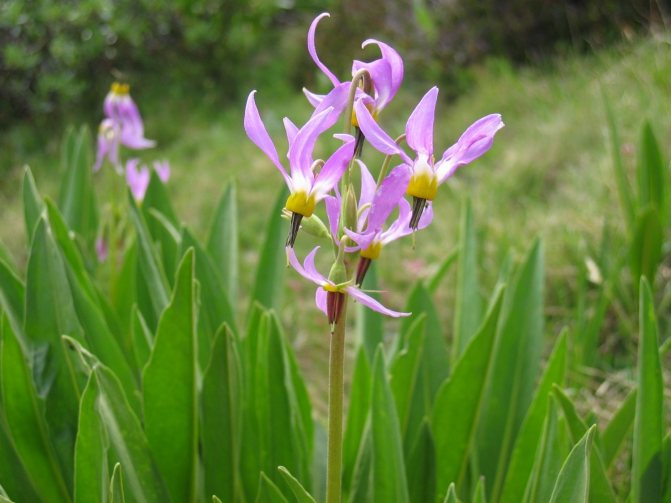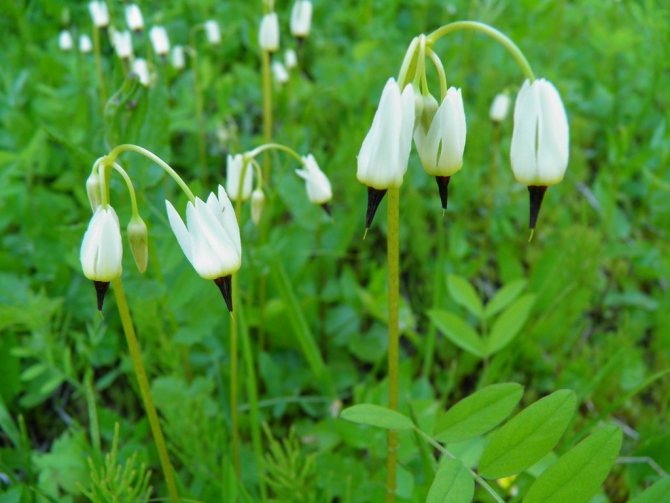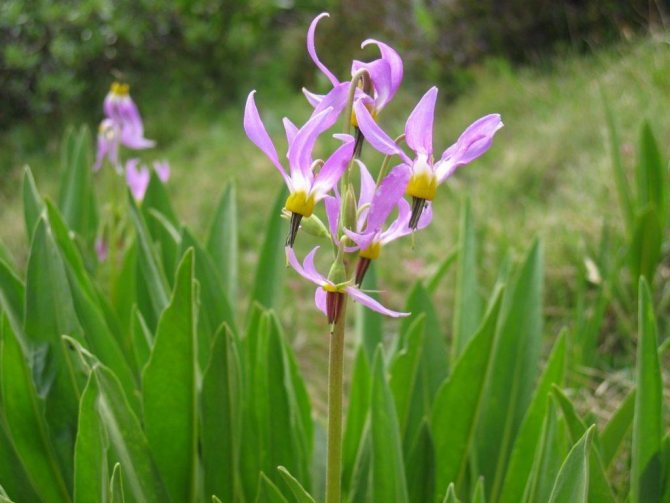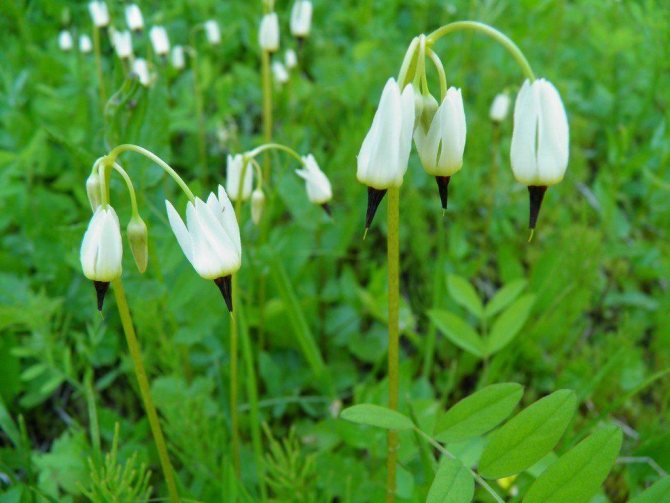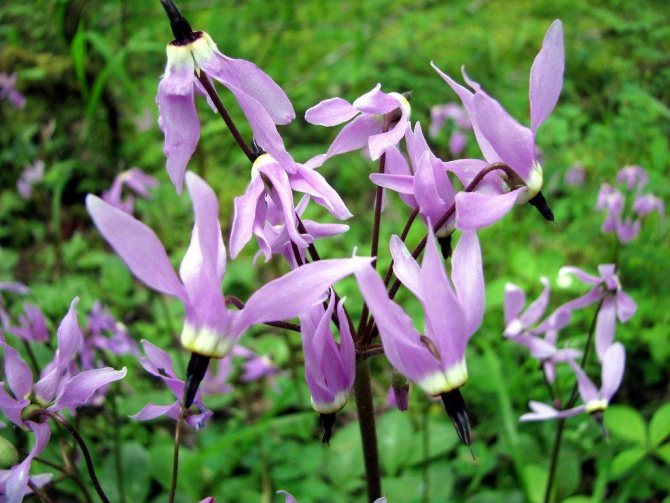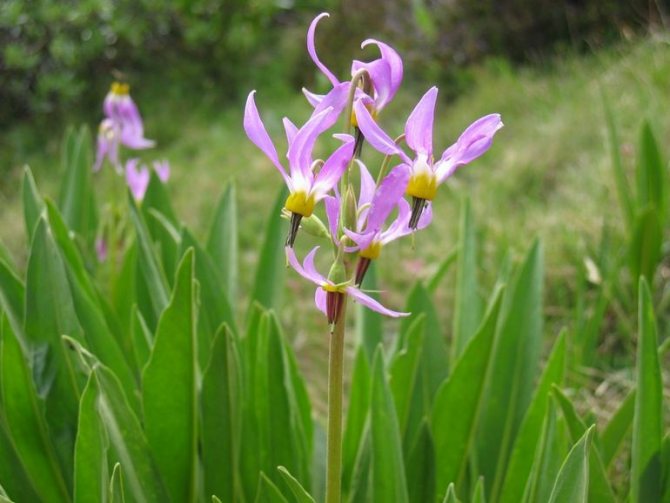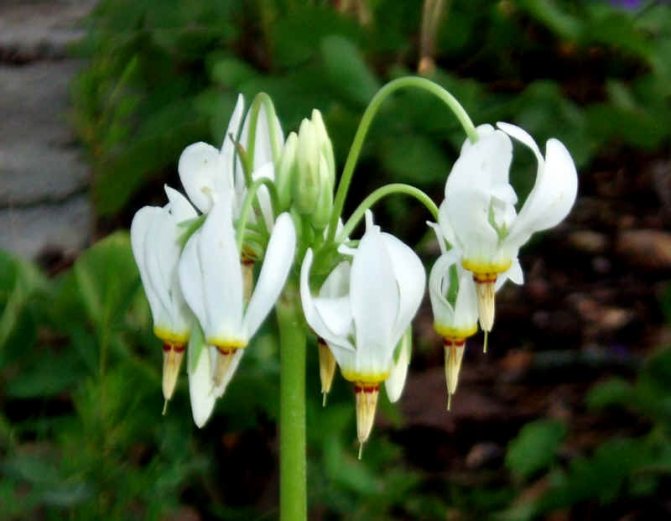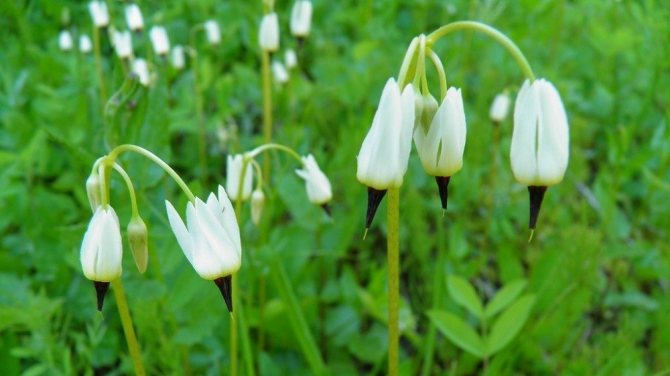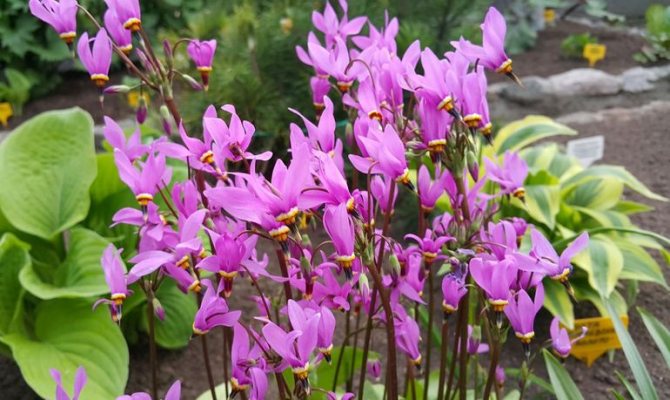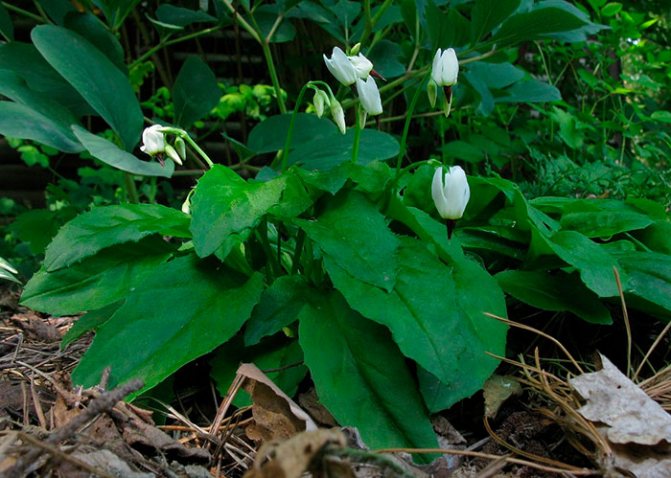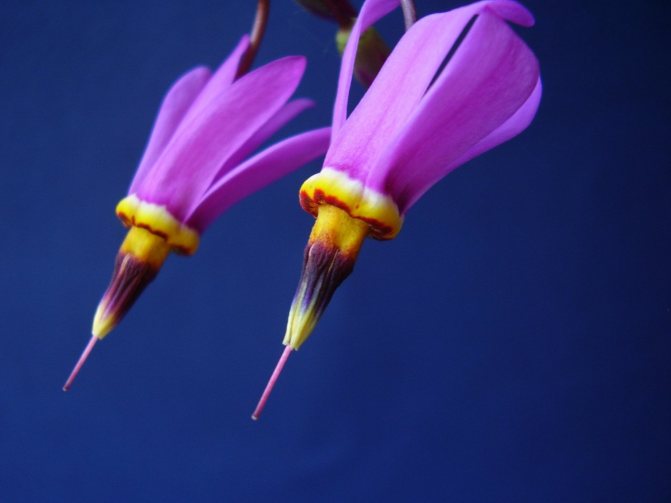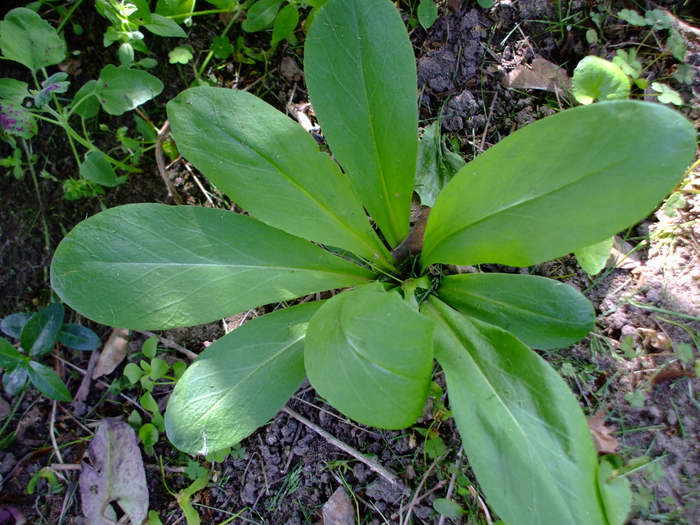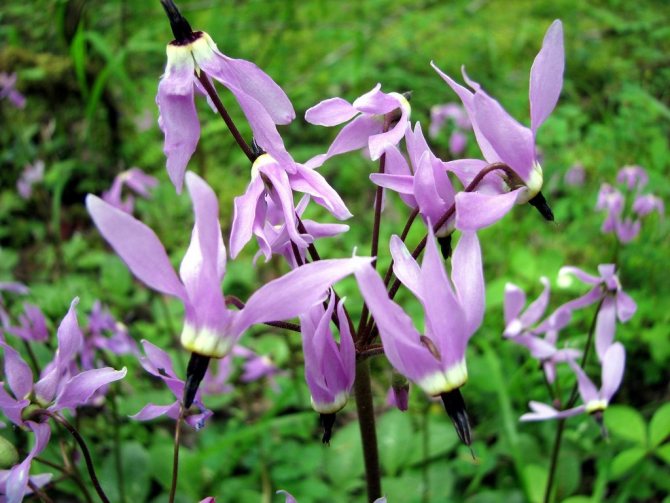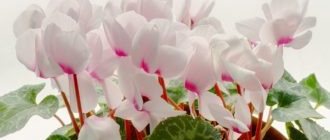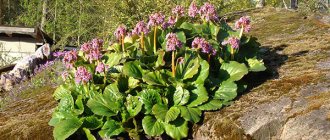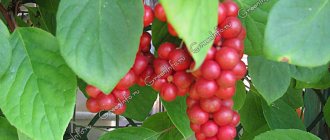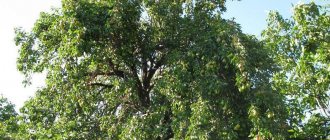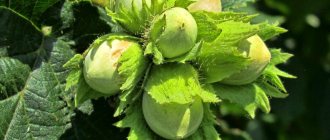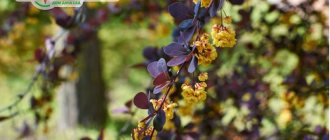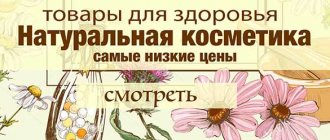Dodecateon, or goose blossom, is a perennial plant with an unusually beautiful flower. It is unpretentious in planting and care, however, it will require some knowledge about this plant from the gardener. Today, 15 species of dodecateon are known, but, unfortunately, not all of us take root, due to climatic conditions.
Beautiful dodecatheon (Dodecatheon pulchellum)
The scientific name of this genus, Dodecatheon, can be translated from Greek as "God's dozen" or "flower of the twelve gods" and, apparently, reflects the number of flowers in an umbrella-shaped inflorescence. This divine theme is reflected in one of the Russian names of the plant: in pre-revolutionary Russia, the dodecateon was called “a panicadillo (a chandelier is a hanging chandelier in a church).
Dodecatheon is a perennial herb from the primroses family. His homeland is the alpine meadows of North America. The plant is somehow surprisingly neat, it looks modest, but impressive. Among the dense bunches of soft, light green, elongated elliptical leaves rise slender stems, crowned with lovely flowers.
The flowers are somewhat reminiscent of cyclamen flowers in shape, purple-pink, white or yellow, up to 3 cm in diameter, collected in an umbrella-shaped inflorescence. Dodecateon blooms from mid-June for 30–35 days.
Vegetative shoots in plants are shortened, leaves are basal, broadly oval or elliptical, up to 10 cm long. Peduncles up to 50 cm high, in the upper part of which there are numerous very beautiful umbrella-shaped inflorescences, consisting of small (up to 3 cm in diameter) flowers. Their color is white, yellow, pale pink or purple-pink. Their base is decorated with yellow markings and purple specks.
Many species and varieties of dodecateon are known, but, alas, they are rarely found in our gardens. Meanwhile, these very ornamental plants deserve the widest distribution - a pretty dodecatheon (Dodecatheon pulchellum), a toothed dodecatheon (Dodecatheon dentatum), a medium dodecatheon (Dodecatheon meadia). They bloom during the transition period, in late spring - early summer, when the primroses have long since faded, and other garden grandees are just preparing their buds.
|
|
|
Types and varieties with photos
Among the currently known dedecateons, several types are most common:
Dodecateon Aphrodite
An early flowering plant with large inflorescences of bright lilac color. At the base of the flower are yellow stamens. The petals are bent back. It begins to bloom in May. The height of the stems is 40-45 cm. The perennial variety Aphrodite grows well in the sun and partial shade. Ideal for decorating alpine slides.
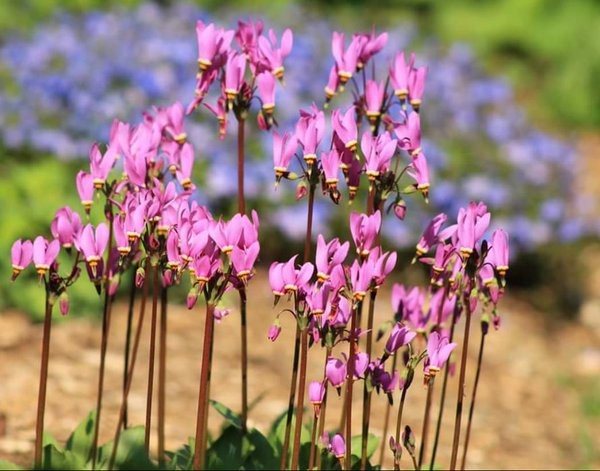

Dodecateon Jeffrey
The dodecatheon Jeffreyi is named after the Scottish gardener who first discovered it. It has inflorescences of five petals and yellow stamens bent upward from the sepal. The shade of the flowers is pink purple. Prefers sunny places, grows well on loamy soil. The height of the stems is 10-13 cm.
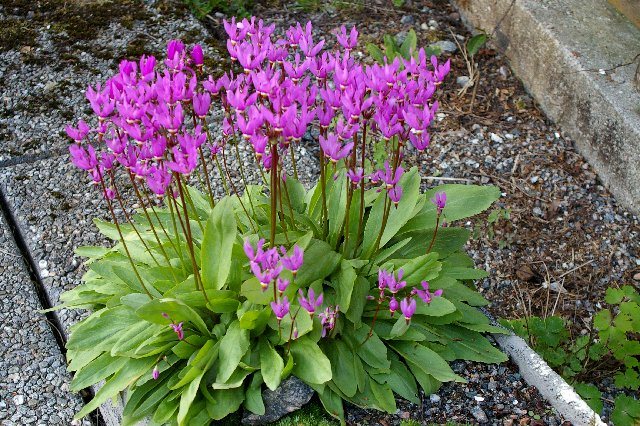

Dodecateon Samson
For the first time, wildflowers resembling shooting stars were seen in North America. Dryakvennik Samson loves wet places, grows in meadows and mountain slopes.The plant is successfully grown in garden plots. Starting from June, the whole summer period blooms profusely. The inflorescences are colored with a rich pink tint. The height of the stems is up to 50 cm.
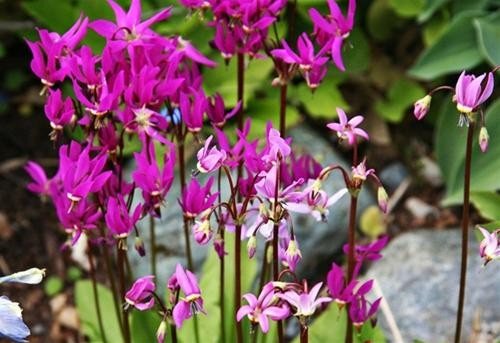

Dodecateon Meadia
A perennial plant has a low rosette of leaves with peduncles prevailing in growth. The color of the inflorescences is from white to light pink. At home, it is called the American primrose. Prefers sunny locations and moist soil. The dodecatheon Meadia is ideal for creating meadow lawns.
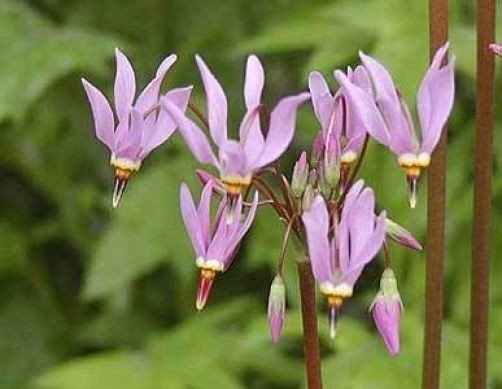

Dodecateon Red Wings
A flower with short vegetative shoots and a high stem with purple inflorescences. Dodecateon pulchellum Red Wings sounds like red wings. The petals bent back seem to be in weightlessness. Due to their bright flowering, they are often used in the design of flower beds, borders and rock gardens. Stem height 10-20 cm.
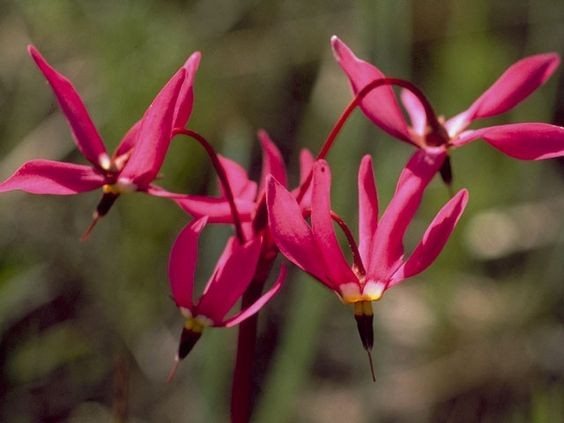

Reproduction of the dodecateon by dividing the bush
A simple, affordable and effective way to reproduce a dodecateon is by dividing a bush. Dryakvennik is propagated in autumn, at the end of September - early October, or in early spring - in March. It is enough just to dig in the plant from all sides, carefully remove it from the ground and carefully cut it with a sharp knife into several parts with two or three growth points each. Then the bushes will be viable, even if one of the buds dies.
They are planted in the usual way in prepared wells. At the bottom it would be nice to put a couple of handfuls of humus, which will become a supply of nutrients for several years. The root collar is not buried, maintaining the same planting level. Water abundantly. The distance between the bushes is at least 10 cm.
Reproduction, growing from seeds
Growing a dodecateon is not easy. It takes a lot of effort to make an elegant flower from a seed. The laborious process from planting seeds to flowering will be rewarded with a whole flower bed of graceful inflorescences. By following simple rules, you can get wonderful results:
- The plants planted take root and bloom faster dividing the bush... To do this, you need to dig up an adult plant, divide the root system into several parts.
- Transplant the plant in autumn or early spring... Some gardeners practice planting shrubs in the summer. This is done during the dormant period, when the plant throws off the leaves.
- Planting seeds, preferably in the fall in groups of 4-5 outlets.
- Before sowing seeds, it is necessary to keep in the refrigerator for several hours... Thus, they will be hardened and less susceptible to frost.
- Sown seeds water abundantly until germination... If weeds grow nearby, they must be removed manually. Otherwise, the roots may be damaged.
- The hardened stems may dry out soon, don't let that scare you. The main thing is that the root develops inside. Seedlings will bloom for 4 years.
Tip: until a flowering bush grows from the seeds, the planting site must be marked. Otherwise, you can inadvertently dig up this area.
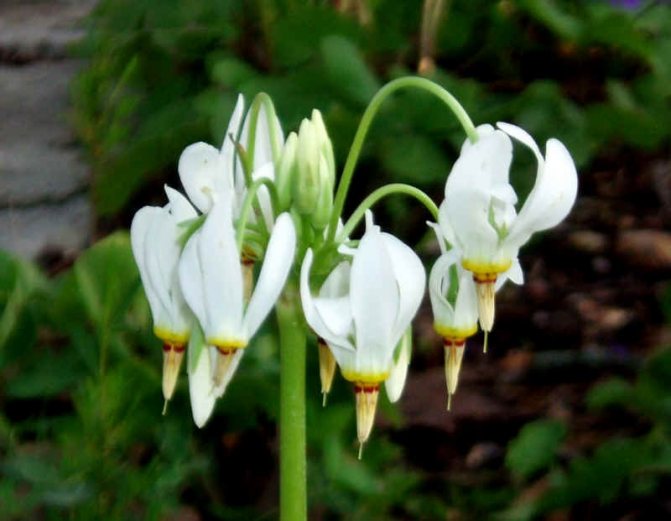

Growing dodecateon outdoors
Growing conditions for dodecateon are unpretentious: the plant takes root on almost any soil. The preferred growing place is weak partial shade without a bright midday sun. The ability to withstand periods of drought and high frosts is especially valuable. However, you still should not test the plant if you want to maximize its beauty.
- Watering should be done in moderation, but regularly, so that moisture is always present in the soil.
- The soil is desirable loose and rich in organic matter, without stagnant water.
- Considering that under natural conditions the dodecateon grows between weeds that die off annually and form a thick soddy layer, it would not be superfluous to mulch the earth's surface.Lay grass or straw around the plant, small organic debris, even needles from the forest will do. So you will also make it easier for yourself to take care of the flower garden: you will not need frequent weeding and loosening of the soil.
- You can feed it during the period of growing green mass with organic or mineral fertilizers containing nitrogen in low concentrations. When the buds begin to set, you can choose a fertilizer containing potassium and phosphorus. These substances are useful for enhancing flowering, and potassium will prepare the plant for a good winter.
However, top dressing is not necessary: the dodecateon blooms beautifully even without additional attention from the grower.
Planting and leaving
Planting should be done in humus-rich soil. Until the flowers take root well, regular watering is required. In the rainy season, so that the roots do not rot from excessive moisture, it is necessary to loosen the soil around the bush.
An important point: with the onset of a dormant state, when the plant throws off its leaves, the dodecateon continues to be watered.
What you need to consider when planting a dryakvennik:
- Experienced gardeners recommend for better growth and speedy rooting soil mulching.
- In order not to rot the roots, do not forget about drainage. Most often used for this purpose expanded clay... It will retain moisture and allow the roots to breathe.
- It is not worth covering the plant for the winter, bushes are able to tolerate frost painlessly.
- After flowering, cups with seeds are formed in place of the inflorescences. If the collection of the passage is not supposed, for aesthetics, the stems can be cut.
- So that the seeds do not peck out the birds after planting in the winter, it is recommended to cover the soil with burlap.
Useful fact: if you do not take into account the lengthy process of growing a bush from seeds, in general, an adult plant does not require special care. It is enough to properly care for it and water it on time.
Using
Dodecateons are good in group plantings near curbs, along hedges or in rock gardens. These moisture-loving plants are suitable for framing small bodies of water. Go well with low-growing conifers or ferns.
Dryakvennik is good because it pleases with flowering one of the first, when other plants are just gaining strength. But it also fades early, and even the foliage falls by August. To prevent bald spots on the flower bed, it is necessary to combine the plant with green ground cover specimens. Good neighbors for the dodecateon will be the European clefthoof, hosta, heuchera, quarry or aquilegia.
Possible problems
- The plant can be troubled by the inhabitants of the wet earth - slugs. An insidious creature can destroy seedlings in a few minutes. An adult flower does not suffer much. However, after the slugs have visited the garden. The surface of the leaves is covered with traces of mucus that are unattractive. Safe modern means will help to fight slugs: the drug Thunderstorm, Antislice, Slugstop, Metaldehyde
- You need to buy healthy planting material in proven places. Unscrupulous sellers can supply damaged roots for sale. Externally, they should not have traces of mold or rot. When buying seeds, you need to look at the shelf life.
- If the roots are not supposed to be planted right away, you need to place them in peat peas and sprinkle them with earth.
- Possible diseases of the unpretentious flower care are not reported.
Sowing dodecateon seeds in open ground
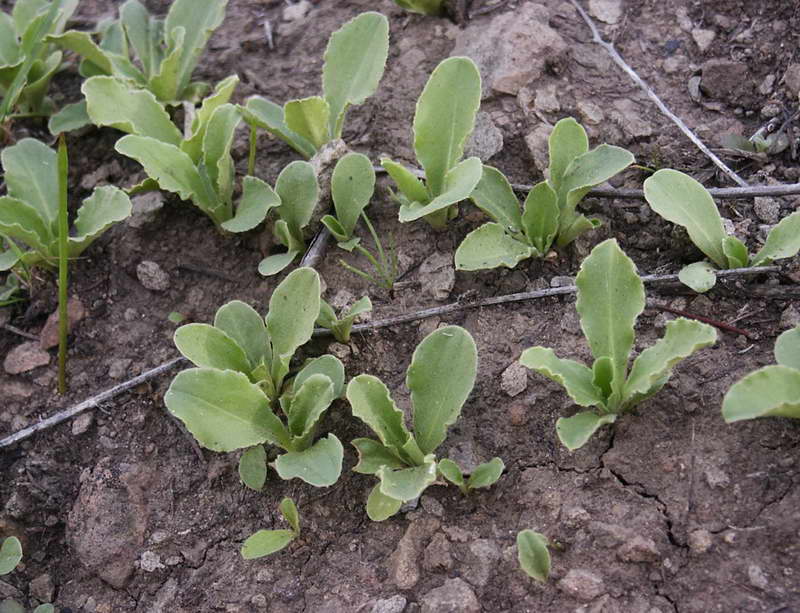

How to sow dodecateon in soil photo
Given that dodecateon grows well and develops quickly when sown directly in open ground, many growers prefer seedless flower cultivation. Sowing time in the ground is from mid-April.
The garden bed is prepared in advance, preferably in the fall, so that the earth subsides properly. Shallow furrows are stuffed at a distance of 15-20 cm and seeds mixed with sand are sown.The sand will allow you to sow less frequently. Remember that the first leaves appear quickly and die off quickly, so do not be upset and wait for the dodecateon to "rise" a second time. Water 2-3 times a week, but do not overflow to avoid crusting. This phenomenon can be prevented by mulching the surface with a thin layer of loose humus immediately after sowing.
When the plants rise and grow up to 5-7 cm, they should be weeded and broken, leaving a distance of at least 5 cm between the seedlings. Finally, the distance for adult bushes must be left at least 10 cm, replanting excess bushes to another place.
Application in landscape design
Bushes with exquisite inflorescences of different shades, look great both in single compositions and next to other plants in alpine hills. The abundantly blooming dodecateon, in a duet with other plants, will create an original landscape composition. Planted plants will look harmoniously next to them:
- undersized conifers,
- wormwood Schmidt,
- pearl anaphalis,
- astilba flowers,
- armeria bushes,
- alpine aster,
- fern,
- primrose,
- Iberis.
Against the background of neighboring plants, the dodecateon (dryakvennik) will become a favorite of an alpine slide or flower bed. Knowing the features of flowers, it is easier to deal with landscape design. Thanks to the division of the roots, a beautiful flower bed can be obtained in several years. A worthy replacement for these colors will be: cyclamen, alpine violet and aquilegia... A perennial plant with unusual inflorescences will delight you with an abundance of beautiful flowers every season.
https://youtu.be/zB5mfzhtlV4
How to propagate and with what other plants in the garden can dodecateon be combined
Goose onion propagation is practiced in two ways:
- seed;
- dividing the rhizome.
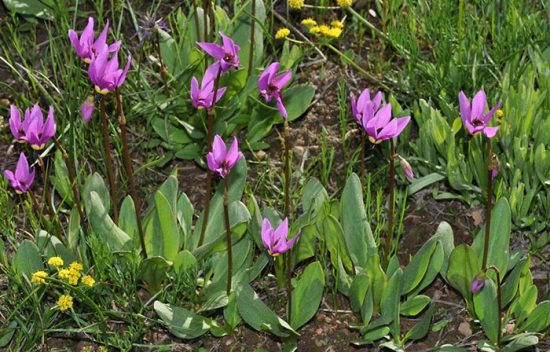

Protect the dodecateon from moisture stagnation in the soil
Sowing outdoors is best done in late autumn. In the case of spring cultivation, the seeds require artificial stratification in the refrigerator for 1-2 months. The flowering of seedlings is possible for 2-3 years.
Attention! In the first season after sowing, only cotyledonous leaves are formed in the dodecateon. Their quick withering away is considered normal.
A simpler breeding method is the division of the rhizome. Usually, it splits itself into 3-4 divisions when excavated. It remains only to plant them in the prepared pits.
The elegant look of the flower allows designers to let their imagination run wild. The dodecateon is good in both group and single plantings. It looks great on rock gardens, in rutaria compositions, by the pond. A combination of goose onions with conifers, ferns, astilbe is recommended.
This beautiful and still rare plant in our gardens is appreciated by amateurs for its attractive appearance and unpretentious care. Seeing a blooming dodecateon and not falling in love with it is simply impossible.
Landing a dodecateon: step-by-step instructions
Dodecateon in the garden will be an excellent decoration and will delight you with bright and spectacular flowers in the spring. Planting this plant will not be difficult if all the necessary steps are correctly followed.
Stage 1. Selection and acquisition of dodecateon planting material
- First of all, you need to purchase the planting material of this plant. In this case, there are several options. You can buy dodecateon by seeds and sow it in open ground on your site.
- Some gardeners prefer not to waste time and energy on growing seedlings, so they turn to nurseries where they professionally grow plants and buy ready-made seedlings or cuttings of this plant there.
- It is also important to decide on the variety of the dodecateon. Not all varieties of crops can be grown on the territory of Russia, so it is worth giving preference to those varieties that feel great in temperate climates, for example, a medium dodecateon or a pretty dodecateon.
Stage 2.Choosing a site for landing a dodecateon
- At the next stage, it is important to choose a place for planting this plant.
- This plant prefers to grow in soft and diffused light, so it is best to choose a piece of land for planting a dodecateon that is illuminated in the morning or evening.
- A good perennial grows both in a sunny place and in a light shade.
- It is important to ensure that the site is slightly sheltered from strong winds.
- Do not forget to put identification marks at the landing site of the dodecateon, since after the dying off of the upper part it will be difficult to understand where the plant is growing.
Stage 3. Selection and preparation of soil for planting dodecateon
- Dodecateon is considered an unpretentious plant that can grow well on any soil. The main thing is that the soil should be nutritious and fertile, and also let through not only air, but also moisture well.
- Therefore, before planting this plant in the ground, you need to take care of the preparation of the soil mixture.
- First of all, you need to carefully dig up the selected area with a pitchfork or shovel, after which the place needs to be loosened and leveled. It is also recommended to apply fertilizers, you can add a little humus.
Stage 4. The process of planting the dodecateon in open ground
- Dodekton seedlings can be planted in open ground in spring or autumn.
- Beforehand, it is necessary to prepare the landing holes at the chosen place. The depth of each hole will depend on the root system of the seedlings, but on average it should not be more than 8-10 cm. If you are planting a group of plants, then be sure to keep a distance of 10-15 cm between the holes.
- After that, each hole needs to be spilled a little with water.
- Next, carefully using the transshipment method, it is necessary to remove the seedlings from pots or containers, while trying not to damage the root system.
- You need to plant seedlings at the same level, without deepening the root collar.
- After planting, young plants are watered with water, and the surface of the earth around them is mulched with humus.
- The first weeks after planting, you need to water the bushes more often.
Distinctive features of the plant
The goose-colored homeland is considered to be North America. As noted above, botanists count about 30 plant species, but we cannot see even half of them, due to climatic conditions. Most often, dodecateon can be found in mountainous wooded areas. Such an unusual arrangement of the plant speaks of:
- goose-colored endurance
- resistance to sudden temperature changes
- resistance to any whims of the weather (for example, showers, strong winds and even the first, minor frosts)
Our country is located in the middle lane, so the plant feels just fine: it takes root quickly, gives the first color and blooms profusely. Note that the goose bloom grows in the form of a root rosette. It has a rather long, green stem, on which a flower calyx forms during the growing season.
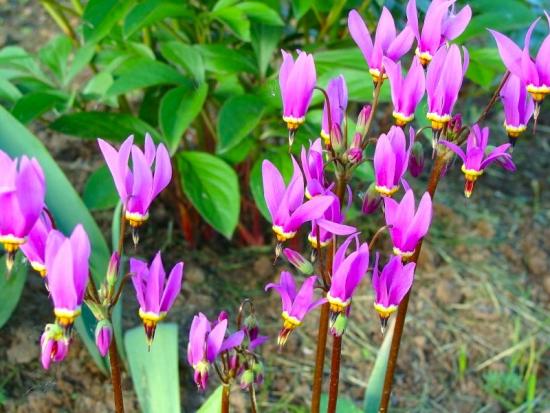

Dodecateonoma flowers are small and rarely exceed 3 centimeters. As it blooms, the petals of the plant completely open the golden dust particles, and they themselves move back. Such an unusual flowering lures invertebrates. Dodecateon is a wonderful species of melliferous plant. In botanical textbooks, the scientific name for goose-colored sounds like "pretty dodecateon."
It is impossible to refute or dispute this name, because the plant is really famous for its unusual and original appearance. Today the flower can be found not only in gardens, but also in parks and squares.
So, dodecateon is a perennial plant that has light green leaves. The flower is unpretentious in planting and care, and perfectly tolerate any "whims" of our climatic conditions. Very often goose color is used in decorating parks, squares, gardens.
How amazing he is, this dodecateon
Reddish-pink, snow-white or yellow large (about 3 centimeters in diameter) flowers form an umbrella-shaped inflorescence.Flowering begins in June and lasts for 30 days.
Growing conditions
The plant develops equally well both in open and shaded areas. The soils are light, loamy, moist, but well-drained.
Application
Dodecateon looks great in border and group plantings, goes well with ferns, astilbe, dwarf conifers. Can be grown for cutting. Looks great in rocky gardens.
Care
Watering is plentiful, regular. stagnation of water on the site is unacceptable. Light mulching is desirable. The plant is winter hardy.
Reproduction
Dodecateon propagates by seeds or by dividing the mother bush (in autumn or spring). Before sowing, seeds are stratified in the cold for 1-2 months. Sowing is carried out in the spring. Seedlings bloom in the second or third year.
Diseases and pests
Dodecateon is rarely affected by diseases and pests.
Popular varieties
Common dodecateon varieties:
- ‘Red Wings’ - a plant up to 20 centimeters high, with crimson flowers;
- ‘Alba’ is a plant about 20 centimeters high with white flowers;
- ‘Pink stork’ is a plant up to 40 centimeters high. Dryakvennik 'Pink Stork' is distinguished by large (up to 4 centimeters in diameter) lilac-pink flowers.
Back to the list
When does the dodecateon bloom?
Flowering occurs in early June and lasts about 40 days. Shades of petals - from pale lilac, pink and purple to white. After flowering, the plant forms a seed box-barrel, which contains many small seeds. Flowering ends around mid-August, and the dying off of the aerial part begins. Just a few days is enough for the leaves to wither and dry.
[collapse]
Review on video
Channel Vokrug Sveta TV continues to talk about rare, unusual cultures in Russian gardens. This program is about the bastard.
Daylilies: the best varieties with photos and names
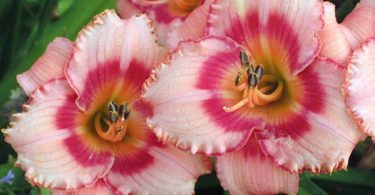

Lilies La-hybrids: purchase, planting, care, the best varieties with photos
